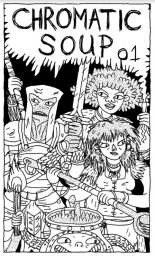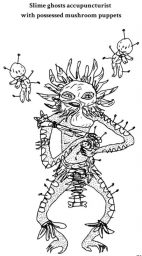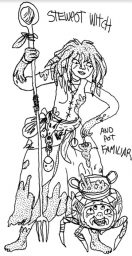Game Conversions and Chromatic Soup 01
Thursday , 4, May 2017 Tabletop Games, Uncategorized 3 Comments It’s obvious that the rules of a game influence the play of the game. After all, they are the game. But, for role playing games there seems to be this idea that system doesn’t matter. This is so obviously wrongheaded that it seems like it would have been dismissed immediately. Yet people keep coming back to this idea. Taking an rpg setting and playing it with the system you like seems to compel many a gamer. For example using Original D&D with the Harn setting rather than the Harnmaster rules. On the face value, it doesn’t seem too crazy as both are quasi-medieval fantasy rules. But, anybody who has played both systems will know that despite the setting, the Original D&D game played will differ significantly than the Harnmaster game played. They will be so different in fact that you can hardly say Original D&D Harn is the same as Harnmaster Harn. So, despite all the detailed window dressing of Harn (and is there an RPG setting that has more window dressing than Harn?), Original D&D Harn will be in essence Original D&D. So, my thesis is this: system is setting.
It’s obvious that the rules of a game influence the play of the game. After all, they are the game. But, for role playing games there seems to be this idea that system doesn’t matter. This is so obviously wrongheaded that it seems like it would have been dismissed immediately. Yet people keep coming back to this idea. Taking an rpg setting and playing it with the system you like seems to compel many a gamer. For example using Original D&D with the Harn setting rather than the Harnmaster rules. On the face value, it doesn’t seem too crazy as both are quasi-medieval fantasy rules. But, anybody who has played both systems will know that despite the setting, the Original D&D game played will differ significantly than the Harnmaster game played. They will be so different in fact that you can hardly say Original D&D Harn is the same as Harnmaster Harn. So, despite all the detailed window dressing of Harn (and is there an RPG setting that has more window dressing than Harn?), Original D&D Harn will be in essence Original D&D. So, my thesis is this: system is setting.
Another example comes from play. The other week in the regular Mutant: Year Zero game I play in, I had an unexpected experience due to this being only our third session and generally still getting used to the system. In the game, I attempted a scouting roll to try to determine the dangers inherent in an abandoned swimming pool/exercise facility we had found. I rolled poorly with several failures and no successes. It’s a dice pool game and ones are failures and sixes are successes. A feature of the system is that you can elect to “push” a roll and reroll any dice that were not ones in attempt to get a success with the provision that any subsequent failure results in damage to the ability stat used in the test. So, the situation was ominous and I really wanted to know what was lurking and so I pushed it despite poor odds and failed spectacularly. The result is I took four damage to my “wits” stat and fell unconscious. One more failure and I would have died since having any stat reduced below zero means death. I knew the rule but, this result was astounding to me. Why would someone go unconscious for failing to find a danger? Who knows? In many another game such a thing would not happen. A D&D Ranger failing a tracking roll will simply lose the trail. But, fall unconscious? Never. One can argue that the system in Mutant: Year Zero poorly models reality (or, in gamer speak: this system is broken). But is it broken? I’d argue not, because immediately, we players at the table began kibitzing as to why this effect might occur. A number of rationalizations were proposed and eventually we landed on this one: the characters are all diseased and radiation poisoned mutants, right; so, maybe thinking and concentration is not our strong point and this level of mental stress is quite beyond us. Mutant: Year Zero characters may go catatonic under stress in a way that would not happen, for example, to Aragorn. Even for superficially similar settings of game like Gamma World this thing would not have happened. Mutant: Year Zero is a setting where characters can go catatonic from thinking too hard. Get used to it. System is setting. Oh, and the failure of the scouting roll resulted in the party being surprised by a giant mutant spider. The party fled dragging my character’s unconscious body to find refuge in an abandoned fallout shelter.
But, does setting have no influence if the rules are so overarching? No, setting has its influence too. The geography of a setting obviously influences what play occurs. The deserts of Athus in the D&D Darksun setting will result in a different game play than say the jungles of Qelong for the Lamentations of the Flame Princess rules. Even the naming of things may influence play as names can set a tone of a place and players can be influenced in their choices by that tone. Each pairing of system with setting is ultimately a different game. Setting is also system.
And, this leads me to one of the features of the early role playing game rules versus the later generation rules from the 1990s and beyond. The early games more often than not held the assumption that the play would decide a lot of the nature of the setting while later games fully integrated setting with system. Most later era games give rules to play in a very specific setting. Mutant: Year Zero being a recent example of this. Numerous other examples abound: Shadowrun, Space 1889, Vampire: the masquerade, Dogs in the Vinyard, etc. And, while some of the games have been ported to other systems, the reality is that the rules present no option for a GM from using his own setting. The old rules give a starting point to create your own game. The new rules give the ending point of a very specific game.
Given all of the above, here’s short review and a suggestion for a conversion of a setting to a different system. Recently published was the first issue of Chromatic Soup (Chromatic Soup 01), a role playing collective “zine” which has plans for bimonthly releases of about 40 pages or so. But, this first issue clocks in at 177 pages and is fundamentally a role playing setting for OSR (Old School Revival) type systems. That is it is intended to be used with D&Dish systems to further the creation for a gaming group to create their own game. It packs a lot into those 177 pages. Illustrated, edited, and published by Cedric Plante along with fifteen contributing authors it is quite an evocative, quirky, and fun presentation that does a lot of things right. The first of which is that that it leave a lot of details out. For example the regional maps have no scale. The maps present the relative relationship between features but, it leaves it up to the GM to determine distance and travel times which allows the setting to be shoehorned more easily into just about any existing campaign. Without going into too much detail it covers three broad regions: Swamp Land; Flatstone Fortress; and Rice Fields Land. It’s a hex crawl without hexes. Now, this is not a setting where a GMs (and players!) have no work to do. Everything is presented in a sketched-in form that gives wonderful details without necessarily explaining everything which leaves tons of room for GM planning and improvisation during play. This is a good thing. Trust me. In brief, Swamp Land is a mucky dangerous place ruled by the Swamp Duke and his hippo riding Swamp Marines. The Swamp Land is chock full of oddities that I can’t describe in detail here but, whose very names inspire the imagination: Log-Jaw Pipers (a new class); Pearl Divers of the Black Snake River; Stew Pot Witches; Bobcatmen; the Goblins of the Spoonbill Clan (who fight with bolas, javalins, and two-handed warspoons); catfish dragons; and dreaded Brood Golems. Flatstone Fortress is inhabited by reptilian Merchant Knights who form sacred connections with Brood Golem’s eggs and whom will only trade with those who they believe to be worthy. And, Rice Fields Land is a chinoiserie of magic rice, mosquito and tick fae; steam shapers (who draw magic from rice); and demon turtles. There is a lot of wonder in Chromatic Soup 01 and all I can say is that any GM who can’t find some inspiration there isn’t trying. And, it has appendices (all the best RPG products do) one of which gives conversion to the Runequest system. So, Chromatic Soup has a built in assumption that people may want to convert it to other systems.

Here’s my suggestion for converting the Chromatic Soup 01 to another system. Last column I reviewed the Tequendria, Lord Dunsany inspired, game. Upon reading Chromatic Soup 01, it seemed to have a similar feel to much of Lord Dunsany’s work (to me at least). I think the classes, monsters, and magic presented in Chromatic Soup 01 would play very nicely with the lands of Dunsany and also work well with the Unbelievably Simple Roleplaying system that Tequendria uses. And, Trollish Delver Games has published on their website a link to a USR/D&Dish conversion created by Kyrinn S. Eis. The method presented can be used in the other direction as well — to convert D&D-style statistics to USR. Some imagination will be needed given how USR archetypes work but, this should pose little trouble to most DMs. Maybe a whole new game will emerge? In any case, I am looking forward to the next issue of Chromatic Soup, it’s one to watch.
Dogs in the Vinyard?
-
Alternative Western RPGby D. Vincent Baker loosely based on Mormon history in Utah.
https://en.wikipedia.org/wiki/Dogs_in_the_Vineyard
http://nightskygames.com/welcome/game/DogsInTheVineyard
-
It’s by an atheist edgelord ex-Mormon. Same level of ‘hurr-durr stupid xtians’ as ‘Handmaid’s Tale’ minus the overwrought literary pretensions.
-